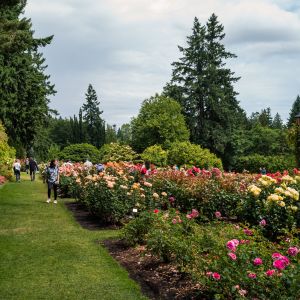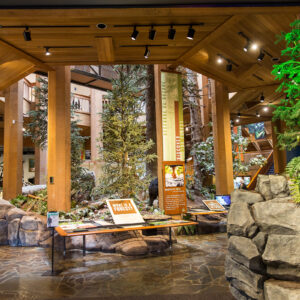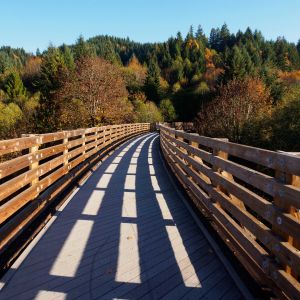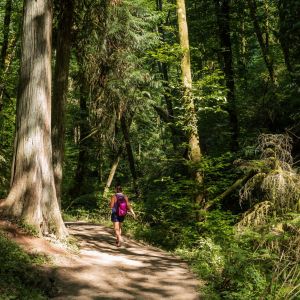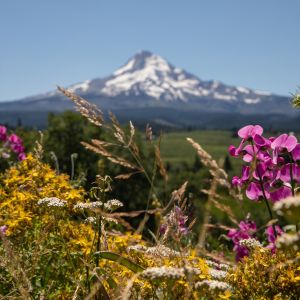
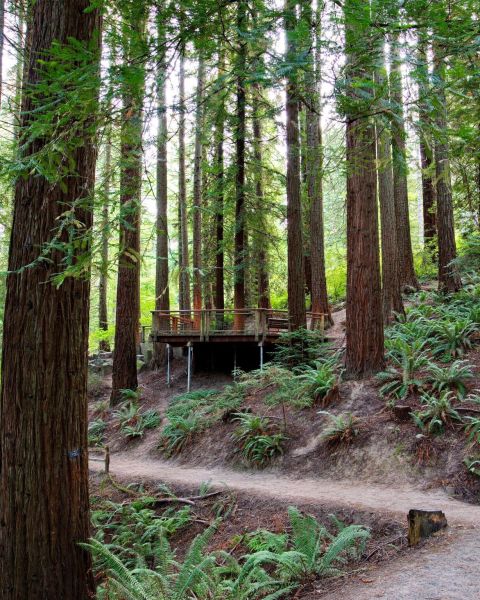
Hoyt Arboretum: Portland’s Museum of Trees
Explore Hoyt Arboretum, home to 2,300 species of trees and shrubs, in Washington Park near downtown Portland.

Matt Wastradowski
Matt Wastradowski is an Oregon-based travel writer who loves writing about the great outdoors, craft beer, and regional history.
Portland has long been synonymous with its scenic outdoor spaces. More than 150 parks dot the city while Forest Park is one of the largest urban parks in the United States. Even one of our nicknames — Stumptown — is a nod to the prolific forests that once covered our modern-day city.
But little stirs the imagination like Hoyt Arboretum, a so-called “living museum of trees” just 10 minutes from downtown Portland. Here, at the edge of Washington Park, visitors can hike 12 miles (19.3 km) of trails through a curated forest of 6,000 trees from six continents — including 67 species that are considered rare or endangered. So, while you’ll see plenty of Douglas fir (Oregon’s state tree), you may also encounter stately redwoods, a small bamboo forest and a weeping beech (whose drooping blooms are so numerous, they hide the tree trunk altogether).
Hoyt Arboretum FAQ
Do I need tickets for Hoyt Arboretum?
When can I visit Hoyt Arboretum?
Where is Hoyt Arboretum?
Is Hoyt Arboretum accessible to people who use wheelchairs?
Are there redwood trees at Hoyt Arboretum?
How many acres is Hoyt Arboretum?
If you’re inspired to see the collection up close, here’s a look at the history, top attractions and special events at Hoyt Arboretum — one of Portland’s most iconic attractions.
Hoyt Arboretum History
For centuries, Hoyt Arboretum was a forested ridgetop covered in Douglas fir, western red cedar, bigleaf maple and other species of trees just west of modern-day downtown Portland. That began to change when a poor farm, established nearby in 1868, was relocated.
The farm moved to Troutdale in 1911, inspiring Portland Parks Superintendent Emanuel Tillman Mische to champion the creation of an arboretum — essentially a curated garden of trees — on the newly vacant land. City planners wanted to build homes and a golf course, and it took until 1928 for officials to approve the creation of Hoyt Arboretum. The first trees were planted in 1930.
Today, Hoyt Arboretum — named for Ralph Warren Hoyt, a Multnomah County commissioner who advocated for the park’s formation — represents roughly 2,300 species of trees and shrubs, much of which can be accessed via interconnected hiking and walking trails.

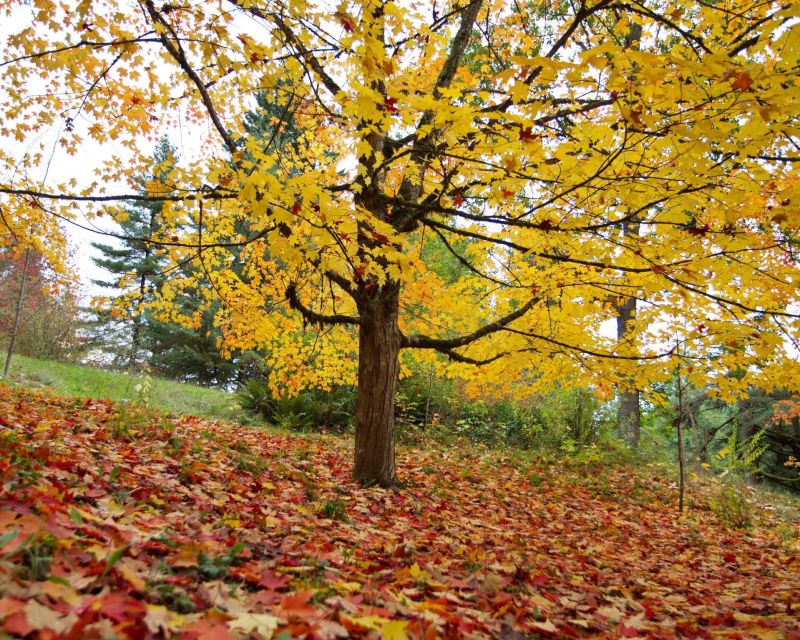

What to See at Hoyt Arboretum
Hoyt Arboretum Visitor Center
Get started at the Hoyt Arboretum Visitor Center. Highlights include trail maps, an outdoorsy gift shop, drinking water, public restrooms and recommendations from friendly volunteers to help make the most of your time. Enjoy a snack on a few shady picnic tables nearby.
Note that paid parking is limited around Hoyt Arboretum and at its visitor center, especially on sunny weekends in spring and summer. Consider visiting via TriMet, rideshare or the Washington Park Free Shuttle.
Washington Park Attractions
Spend a day (or a few of them) exploring Washington Park's other attractions.
Redwood Trees at Hoyt Arboretum
One of the best-loved attractions at Hoyt Arboretum is the park’s collection of 70 redwood trees — including coast redwoods (the earliest of which was planted in 1931), giant sequoias and a colorful dawn redwood whose leaves turn copper and yellow in fall.
Bask in the beauty of these giants from the Redwood Deck, an observation area that’s outfitted with a few benches at the northern edge of the arboretum. From the visitor center, the easiest access to the grove comes via the Fir Trail and the Redwood Trail.
Spring Blossoms and Fall Foliage
Every spring and fall, Hoyt Arboretum comes alive with vibrant pops of color that signify the changing seasons.
Spring blooms include flowering Fuji cherry trees — which turn magenta, pink and white between mid-March and mid-April along the Wildwood and Hawthorn trails; nearby magnolia trails turn a creamy white in late May and June. Wildflower blooms in April and May, meanwhile, include the three-petal trillium plant and yellow Oregon grape.
In fall, colorful foliage covers large swaths of the park in bold hues of orange, yellow and red. The Maple Trail is ground zero for leaf peepers and offers a close-up look at nearly 130 species of maple tree that grow at Hoyt Arboretum. For a different kind of fall experience, check out the park’s American smoke wood trees (found near the intersection of the Hawthorn and Wildwood trails) — whose autumn displays bring softer hues of green, purple, orange and yellow.
More Outdoors, Parks and Gardens
Explore more of the abundant natural beauty Portland has to offer.
Outdoors
The perfect launchpad for outdoor activities and adventure with snow-capped mountains, the Pacific Ocean, countless rivers, forested hikes and beautiful urban gardens, Portland has something for every type of outdoor enthusiast.
Parks & Gardens
In a city as green as Portland, it’s only fitting that some of the top attractions are spots that appeal to home gardeners and hikers alike. With more than 275 parks and gardens within city limits the urban greens offer a breath of fresh air.
What to Do in the Columbia River Gorge
Just 30 miles (48 km) east of Portland sits the Columbia River Gorge — a rugged canyon on the broad Columbia River and home to more than 90 waterfalls, countless hiking trails, plenty of water sports and several charming communities.
The Best Hikes at Hoyt Arboretum
In all, 12 miles (19.3 km) of hiking trails crisscross Hoyt Arboretum — and many can be stitched together to form outings of varying lengths for hikers of all skill and experience levels. Here is a sampling of the best hikes at Hoyt Arboretum:
Fir Trail
Enjoy a mostly level, 0.5-mile (0.8 km) round-trip walk on the Fir Trail — where you’ll pass stands of spruce and red pine, thick bushes of salal (a common sight along the Oregon Coast) and groves of fir trees.
Spruce, Wildwood, Redwood Trail Loop
Get a look at some of Hoyt Arboretum’s most popular destinations with this 0.9-mile (1.4 km) round-trip hike; you’ll pass spruce trees from several continents, traverse Wedding Meadow (a grassy expanse surrounded by conifers and snowberry plants) and visit the park’s impressive redwood grove.
Hoyt Arboretum Loop Hike
For a longer outing, consider busting out your hiking boots for the Hoyt Arboretum Loop Hike. The 4.7-mile (7.6 km) hike gains about 425 feet (129.5 m) while offering a mix of all the arboretum has to offer — including a collection of trees native to the Pacific Northwest, a grove of redwood trees and a captivating collection of Asian fir trees.
More Portland Hikes
Take the scenic route — Portland has plenty of options for outdoor adventure.
Events at Hoyt Arboretum
All year long, Hoyt Arboretum hosts a variety of guided walks, classes and identification workshops (some requiring advance registration and a small fee). Here’s a sampling of events at Hoyt Arboretum:
- Tree Time! Preschool Walk: This regular gathering, geared toward children 2–6 years old, includes story time and a family-friendly guided walk.
- Forest Bathing: In recent years, the immersive act of “forest bathing” has gained traction for its mental and physical health benefits. The arboretum hosts occasional two-hour outings with local guides.
- Educational Outings: Seasonal workshops, classes and guided trips showcase local flora — with walks geared toward identifying local conifers, understanding the importance of holly berries and observing mushrooms that grow in Portland every autumn.
Was this page helpful?
